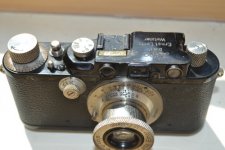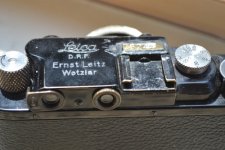mkvrnn
Established
I've just acquired what seems to be a Leica III in black enamel and nickel. It has the slow speed dial and a fastest speed of 1/500 so I'm assuming that it is a III.
The odd thing is that the serial number seems to have been disguised by a plate stuck over the top of it. this plate carries the number 76244. The paint is damaged around the plate, but that could have been caused by somebody trying to clean it up in order to read the number.
My first thought was that it might be a fake, despite the camera coming in its original Leica case and with an original Elmar lens hood. But all the little details seem to be correct so I'm fairly certain that it is genuine. The removable cup around the release button worried me at first, but could that be an aftermarket addition?
Has anybody come across a Leica with a serial number on a plate like this one. If it has been added, why would somebody do that?
There's another issue with the camera - I can't unscrew the lens and the focus lever seems to stop at the wrong places. I'll start another post about this issue.
The odd thing is that the serial number seems to have been disguised by a plate stuck over the top of it. this plate carries the number 76244. The paint is damaged around the plate, but that could have been caused by somebody trying to clean it up in order to read the number.
My first thought was that it might be a fake, despite the camera coming in its original Leica case and with an original Elmar lens hood. But all the little details seem to be correct so I'm fairly certain that it is genuine. The removable cup around the release button worried me at first, but could that be an aftermarket addition?
Has anybody come across a Leica with a serial number on a plate like this one. If it has been added, why would somebody do that?
There's another issue with the camera - I can't unscrew the lens and the focus lever seems to stop at the wrong places. I'll start another post about this issue.



